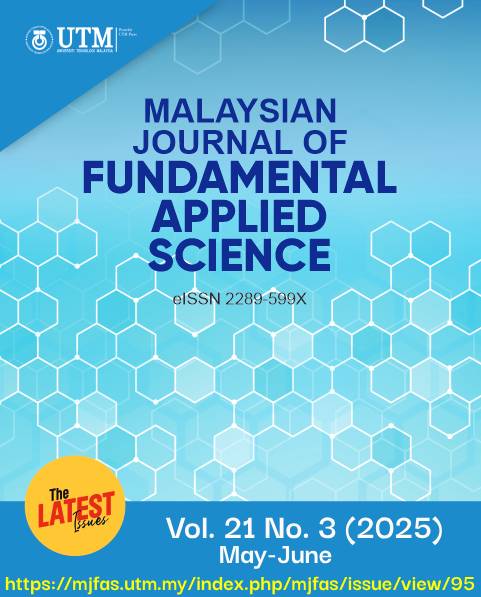Mathematical Modelling Approach in Predicting New Mother Sea Turtle Nesting Patterns at Chagar Hutang Turtle Sanctuary, Redang Island, Malaysia
DOI:
https://doi.org/10.11113/mjfas.v21n3.3946Keywords:
Mother sea turtle, mathematical modelling, exponential, logistic, Gompertz model.Abstract
Sea turtles, ancient marine reptiles that have survived for over 210 million years, now face unprecedented threats from human activities and climate change. This study employs mathematical modeling to predict and understand sea turtle nesting patterns at Chagar Hutang Turtle Sanctuary, Redang Island, Malaysia. We analyzed historical nesting data from 1993 to 2022 using three continuous time models: exponential growth, logistic growth, and Gompertz growth. These models were fitted to the data using Maple Software, followed by rigorous error analysis. The Gompertz model emerged as the best fit, with sum of error of 20.7, significantly outperforming the logistic (28.5) and exponential (1227.2) models. This suggests that sea turtle population growth in the area follows a sigmoidal pattern with asymmetric growth rates. The model predicts a continued increase in new mother sea turtles up to 2030, but with a decreasing growth rate, indicating the population may be approaching carrying capacity. These findings provide valuable insights for conservation planning, highlighting the need for adaptive management strategies and expanded protection efforts. Our study underscores the efficacy of mathematical modeling in predicting sea turtle population dynamics and informs evidence-based conservation strategies for these iconic marine species.
References
Chan, E. H. (2010). A 16-year record of green and hawksbill turtle nesting activity at Chagar Hutang Turtle Sanctuary, Redang Island, Malaysia. Indian Ocean Turtle Newsletter, 12, 1–5.
Chan, E. H. (2006). Marine turtles in Malaysia: On the verge of extinction? Aquatic Ecosystem Health & Management, 9(2), 175–184.
Vaghi, C., Rodallec, A., Fanciullino, R., Ciccolini, J., Mochel, J. P., Mastri, M., Poignard, C., Ebos, J. M. L., & Benzekry, S. (2020). Population modeling of tumor growth curves and the reduced Gompertz model improve prediction of the age of experimental tumors. PLoS Computational Biology, 16(2), e1007178.
Kot, M. (2001). Elements of mathematical ecology. Cambridge University Press.
Zwietering, M. H., De Wit, J. C., Cuppers, H. G. A. M., & Van't Riet, K. (1994). Modeling of bacterial growth with shifts in temperature. Applied and Environmental Microbiology, 60(1), 204–213.
Baranyi, J., & Roberts, T. A. (1994). A dynamic approach to predicting bacterial growth in food. International Journal of Food Microbiology, 23(3–4), 277–294.
Huang, L. (2013). Optimization of a new mathematical model for bacterial growth. Food Control, 32(1), 283–288.
Mazaris, A. D., Fiksen, Ø., & Matsinos, Y. G. (2005). Using an individual-based model for assessment of sea turtle population viability. Population Ecology, 47, 179–191.
Chaloupka, M., Bjorndal, K. A., Balazs, G. H., Bolten, A. B., Ehrhart, L. M., Limpus, C. J., Suganuma, H., Troëng, S., & Yamaguchi, M. (2008). Encouraging outlook for recovery of a once severely exploited marine megaherbivore. Global Ecology and Biogeography, 17(2), 297–304. https://doi.org/10.1111/j.1466-8238.2007.00367.x
Dahri, A. S., Roslan, U. A. M., Damanhuri, H., & Rusli, M. U. (2023). Estimating the population growth curve of sea turtle eggs production in Terengganu, Malaysia: Mathematical modelling approach. Journal of Advanced Research in Applied Sciences and Engineering Technology, 32(1), 332–342.
Downloads
Published
Issue
Section
License
Copyright (c) 2025 Wan Siti Noor Sofea Wan Samperisam, Ummu Atiqah Mohd Roslan, Siti Fatimah Zakaria, Fatimah Noor Harun, Mohd Uzair Rusli, Muhamad Fairus Noor Hassim

This work is licensed under a Creative Commons Attribution-NonCommercial 4.0 International License.




















